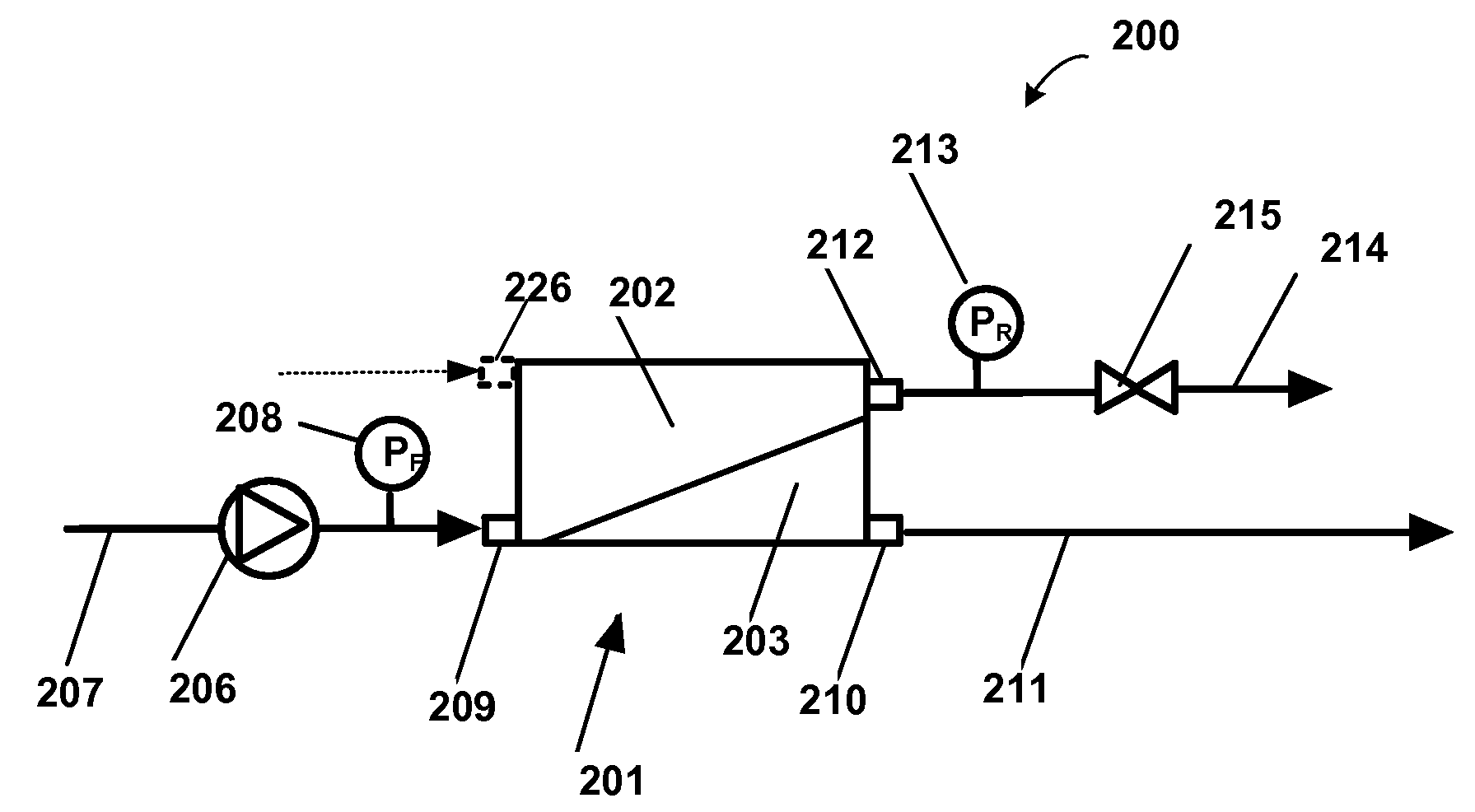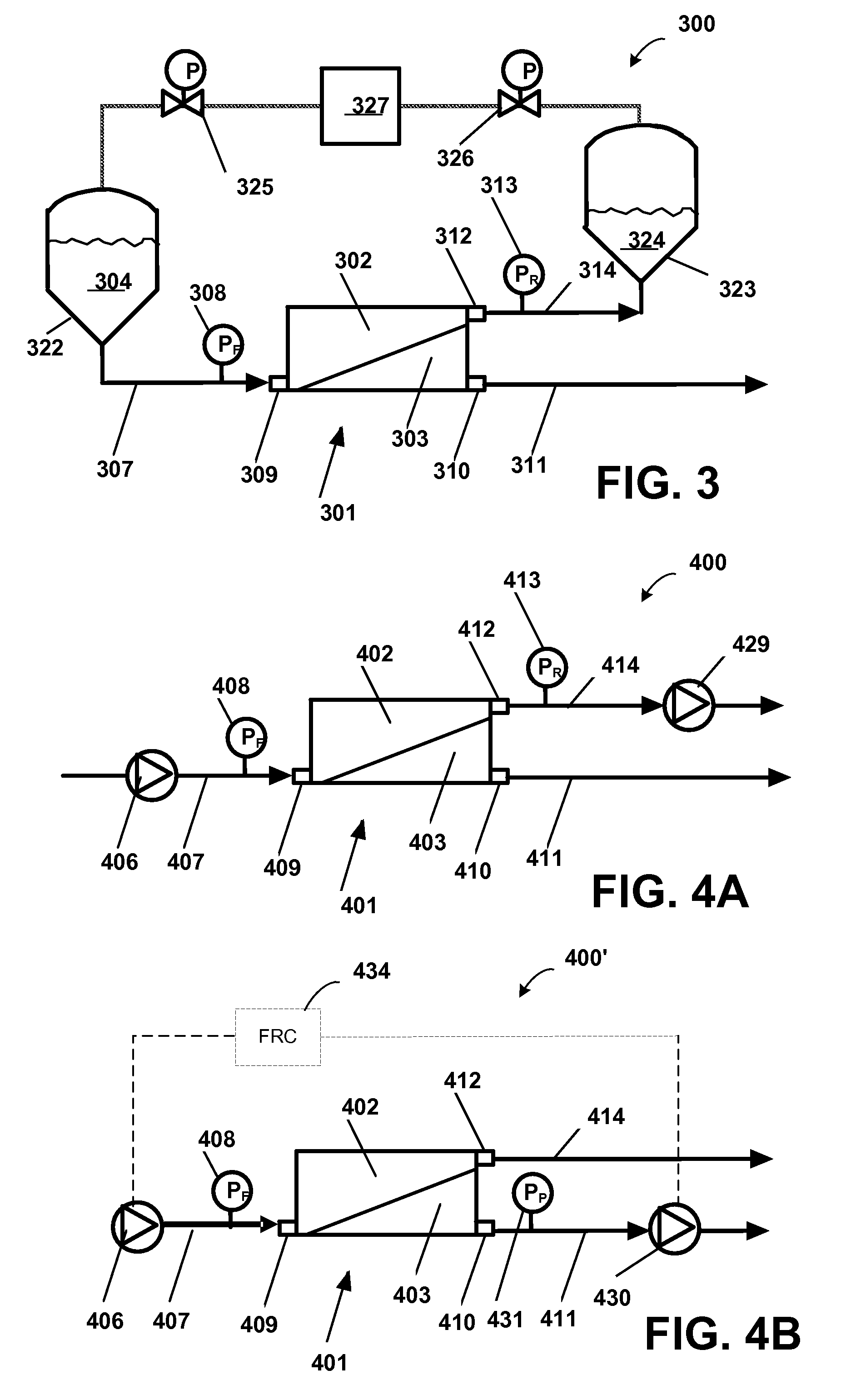[0116]A further
advantage to staging in an SPF system is that staging allows a long flow path without excessive pressure drops. Another
advantage of the present invention is the
elimination of the need to include a pump or other pressure source between stages. Also, a
biopharmaceutical feed
stream can be efficiently processed using conventional filtration membranes with well understood properties in system 700 while achieving a relatively high conversion and reducing system complexity, hold-up volume and
exposure time. There are numerous ways of arranging channels and stages in both internally-staged module and externally-staged systems, including, but not limited to, modules comprising different types of filtration membranes, for example, (a) hollow
fiber membranes, (b) flat-sheet membranes, and (c) membrane monoliths. Staging in which the cross-sectional area for flow of the module decreases along the flow path, can be provided in several ways. In other embodiments, suitable for almost all membranes, one approach is to decrease the number of channels in each stage along the flow path, the dimensions of each channel being substantially the same in all stages. In other embodiments, where the stages comprise rectangular channels, one method is to reduce the width of the channel along the flow path while keeping the specific membrane area of the channel substantially the same. In still other embodiments, the
channel width varies continuously along the flow path, with the width at an inlet of the channel of a stage being greater than the width at an outlet of the channel, and in one example the inlet width is about 1.2 times greater than the outlet width. In other embodiments the inlet width of the channel is about two times greater than the outlet width. In some other embodiments, channels having a continuously varying width are used in conjunction with a staged system, and in still other embodiments, un-staged modules include channels having a continuously varying width. These methods for reducing the cross-sectional area can be combined.
[0117]The staging in system 700 is generally referred to as retentate staging because the retentate from
one stage serves as a feed to the next stage. The boundary between a stage and an adjacent following stage in an SPF multi-stage system can be provided in a number of additional ways. A transition in a
physical property of the membrane in the channels can define a stage boundary. For example the
membrane filter, the dimensionless length of the channels, the hydraulic
diameter of the spacer in the channel, the thickness of the flow channels and the total cross-section for feed flow may change between stages. A stage transition also occurs where there is a discontinuity in the composition of the fluid between a stage and an adjacent stage. This type of discontinuity is affected, for example, by introducing a
diafiltration stream at the boundary of two stages. In a diafiltration system, the stage can include the same number of substantially identical channels as the adjacent preceding stage, and SPF operation is enabled by the introduction of diafiltrate at the intersection of two stages as described below in conjunction with FIGS. 13A, 13B, 18A, 18B, 19A, 19B and 20. Another form of stage transition can be provided by a discontinuity in the operating conditions of the
separation process, for example,
transmembrane pressure in the adjacent stages. Such a transition can be achieved, for example, by a discontinuous change in the pressure of the permeate compartment, the feed compartment, or both. In alternative embodiments the property change can include providing permeate control in each stage as discussed below in conjunction with FIG. 21. A stage transition can also be provided by applying external controls. For example, providing heating or cooling at various stages in system 700. The tailoring of physical properties or operating conditions to each stage leads to improved separation processes. In certain multi-stage embodiments, SPF operation can be achieved without the requirement of σc, being greater than about 40 cm−1.
[0118]In various embodiments, SPF modules with internal staging comprise one or more of: (a) decreased cross-sectional area for flow along the flow path so as to boost the
liquid velocity within the flow channel to compensate for the
lower velocity induced by
permeation and thereby boost the flux performance of the flow channel; (b) increased specific membrane area of the channel along the flow path so as to boost the flux performance of the channel; (c) changed
permeation properties of the membrane along the flow path so as to optimize the balance between flux and rejection in any given stage; and (d) ports and flow passages for the introduction of the diafiltrate at various points along the flow path. Internally-staged modules having some of the properties described above are described below in conjunction with FIGS. 8B, 8C, 9A, and 9B.
[0119]In one embodiment using flat-sheet membranes, the cross-sectional area of a channel is reduced by decreasing the width of the channel along the flow path. The channel height can be varied within the channel, but this alternative is less practical. It has been recognized that these property changes increase efficiency because high conversion leads to lower liquid velocities within a channel. The lower velocities have two potential consequences: reduced flux due to a diminished sweeping action, and reduced TCP. While the lower flux is generally an unfavorable consequence of high conversion, the lower pressure drop per unit of flow
path length enables an increase in the overall flow
path length which leads to higher
single pass concentration factors without resulting in excessive inlet pressures. Property changes along the flow path are implemented so as to increase the flux of the module, for example, by taking
advantage of the reduced TCP obtained by using the SPF process. Changing the sieving coefficient also leads to improved separation effectiveness. In certain embodiments, the channels in the module have a substantially continuously changing
physical property along the flow path or can change discretely as in FIG. 7A. In other embodiments the property change is monotonic between each stage and an adjacent following stage. SPF modules and systems using membrane monoliths (e.g.,
ceramic membranes) are similar in structure and operate similarly to hollow fibers modules and systems as described below.
[0120]Further detailed descriptions of various embodiments of internally-staged modules with staging are discussed in the context of FIGS. 7B, 7C, 8B and 8C. FIGS. 7B and 7C are
schematic diagrams of various embodiments of the cross-section of internally-staged modules in which the staging property change is accomplished by reducing the cross-sectional area for flow along the flow path while maintaining substantially the same channel dimensions, and therefore, maintaining substantially the same specific membrane area of the channel.
[0121]Referring to FIG. 7B, an exemplary module 718 comprises a housing 720, stages 722a, 722b-722n (collectively referred to as stages 722) having a plurality of substantially identical channels 724, here rectangular channels disposed within the housing 720. Each channel 724 comprises a membrane 726 disposed adjacent to a feed spacer 728 which provides support for the membrane 726. In one embodiment, the channels 724 have σc values of greater than about 40 cm−1 and λ values of less than about 6,000. In this embodiment, λstage is equal to λ because there is one channel 724 in the longest serial flow path in the stage, and the λsystem (i.e., the λ of the module) for module 718 is the sum of the dimensionless lengths of the stages 722 and is in one embodiment greater than 2,000. The module 718 further includes an
inlet manifold 730 and outlet manifold 732 fluidly coupled to the channels 724 of the first stage 722a, an
inlet manifold 736 and outlet manifold 738 fluidly coupled to the channels 724 of the second stage 722b, and a passageway 734 fluidly
coupling outlet manifold 732 with
inlet manifold 736. It is understood that module 718 can comprise several additional stages 722 having the same or different number of channels 724 coupled preceding and following stages 722 in a similar way as stages 722a and 722b such that each stage 722 is in fluid communication with each adjacent stage 722 preceding it and is in fluid communication with each adjacent stage 722 that follows it. The module 718 further includes an inlet manifold 740 and outlet manifold 746 fluidly coupled to the channels 724 of the final stage 722n. The outlet manifold 746 disposed in the housing provides the retentate output for further processing through a retentate port (not shown). Module 718 also includes a feed and a permeate ports (not shown).
 Login to View More
Login to View More  Login to View More
Login to View More 


